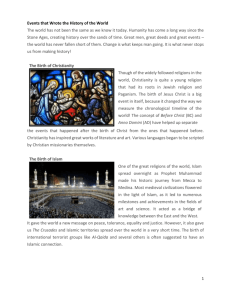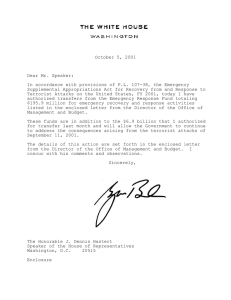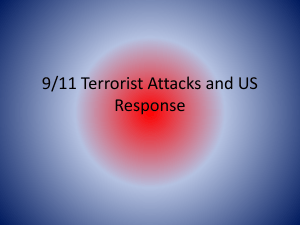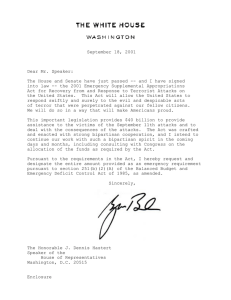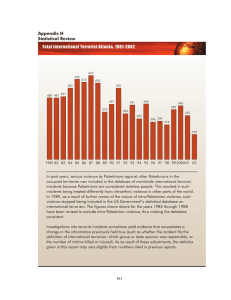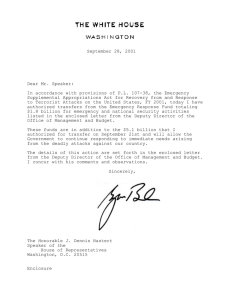May 29, 2002 Congressional Requesters
advertisement
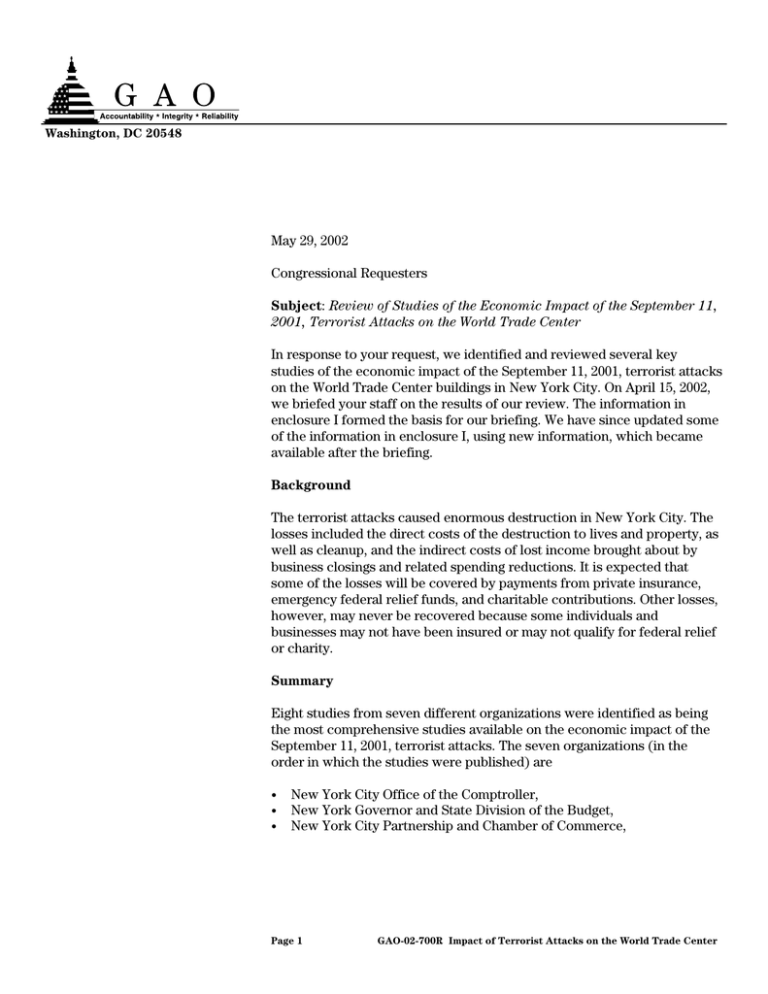
Washington, DC 20548 May 29, 2002 Congressional Requesters Subject: Review of Studies of the Economic Impact of the September 11, 2001, Terrorist Attacks on the World Trade Center In response to your request, we identified and reviewed several key studies of the economic impact of the September 11, 2001, terrorist attacks on the World Trade Center buildings in New York City. On April 15, 2002, we briefed your staff on the results of our review. The information in enclosure I formed the basis for our briefing. We have since updated some of the information in enclosure I, using new information, which became available after the briefing. Background The terrorist attacks caused enormous destruction in New York City. The losses included the direct costs of the destruction to lives and property, as well as cleanup, and the indirect costs of lost income brought about by business closings and related spending reductions. It is expected that some of the losses will be covered by payments from private insurance, emergency federal relief funds, and charitable contributions. Other losses, however, may never be recovered because some individuals and businesses may not have been insured or may not qualify for federal relief or charity. Summary Eight studies from seven different organizations were identified as being the most comprehensive studies available on the economic impact of the September 11, 2001, terrorist attacks. The seven organizations (in the order in which the studies were published) are • • • New York City Office of the Comptroller, New York Governor and State Division of the Budget, New York City Partnership and Chamber of Commerce, Page 1 GAO-02-700R Impact of Terrorist Attacks on the World Trade Center • • • • Fiscal Policy Institute,1 New York State Senate Finance Committee, Milken Institute,2 and New York State Assembly Ways and Means Committee. In addition, recent studies by the Federal Reserve Bank of New York and the New York City Independent Budget Office include updated information on some of the economic impacts. In general, the eight studies we reviewed varied in the extent to which they met standard economic criteria for analyzing economic impacts (see enclosure I for criteria). For example, most of the studies estimated only certain categories of losses and did not estimate the offsetting payments, nor the possible gains from the increased economic activity that the payments might generate. In addition, the studies used different lengths of time to estimate the costs that might be incurred in the future. For these reasons, the estimates that the different studies generated are generally not comparable. Although it was not without some limitations—such as being based on some preliminary information that is now dated—we found that the study by the New York City Partnership provided the most comprehensive estimates, as follows: The attacks on the two World Trade Center buildings cost about $83 billion (in 2001 dollars) in total losses (including both direct and indirect costs); about $67 billion of the losses would most likely be covered by insurance, federal payments, or increased economic activity. Only three of the eight studies used a national or regional perspective in estimating the indirect costs or losses in personal and business income. For example, a falloff in tourist and business travel affected popular destinations throughout the country. Some losses incurred by the New York City economy, in contrast, may have been offset within the national economy, given that some businesses that closed after the attack relocated to New Jersey and Connecticut. The study by the Milken Institute, for example, estimated that for 2001 alone, the economy of the New York-New 1 Fiscal Policy Institute is a nonprofit research and education organization that focuses on New York tax, budget, and economic issues. 2 Milken Institute is a nonprofit organization that conducts research in economics, business, and finance. Page 2 GAO-02-700R Impact of Terrorist Attacks on the World Trade Center Jersey metropolitan area sustained income losses of about $2.7 billion, while all the metropolitan areas in the country sustained losses of about $191 billion. In addition, since most of the studies were completed—or were based on information developed--in the immediate aftermath of the attack, the estimates of impact were based on preliminary information that is now, in some cases, dated. For example, the study by the New York City Partnership and the New York Comptroller’s Office estimated that it would cost from $5 to $6 billion to clean up the site of the World Trade Center and the surrounding areas and that the cost in loss of life (in terms of foregone income) would be from $10 billion to $11 billion. More recently, an official with the New York City Comptroller’s Office indicated that, as of April 4, 2002, the cleanup of the World Trade Center site has been quicker and cheaper than initially estimated. Additional costs could be incurred, however, if the foundation at the World Trade Center site needs repair. New York City’s Independent Budget Office reported that, as of March 15, 2002, the city had spent about $825 million for World Trade Center-related costs, including about $350 million to remove debris. In addition, the Federal Reserve Bank of New York recently reported that because fewer lives were lost than initially feared, the cost in loss of life would be about $6 billion. Furthermore, the U.S. economy has rebounded from the slowdown that was already under way when the attacks occurred. Several studies estimated that the slowdown would continue into 2002. Although the economic recovery in New York may lag behind the national recovery, the stronger-than-anticipated U.S. growth may, to a certain extent, have mitigated the economic impact of the terrorist attacks. Consequently, the estimates of losses from the attacks are likely to continue to evolve as activities, such as cleanup and stabilization, are completed and as factors, such as the long-term consequences of the attacks on the health of the survivors, become known. Finally, although more data on the performance of the economy since September 11 are becoming available, the more distant the attacks become in time, the less easy it may become to disentangle the economic impact from other events, such as the fallout from the Enron bankruptcy or changing macroeconomic conditions. Agency Comments We provided a draft of this letter to the seven different organizations for their review and comment. The chief economists at the Fiscal Policy Page 3 GAO-02-700R Impact of Terrorist Attacks on the World Trade Center Institute and the New York State Assembly Ways and Means Committee, the Associate Fiscal Analyst at the New York State Senate Finance Committee, and the Director of Regional and Demographic Studies at the Milken Institute provided oral comments. They generally agreed with the way we characterized their studies, but provided clarifications and editorial comments, which we incorporated throughout the letter, as appropriate. The New York City Office of the Comptroller declined to comment on the draft. In a May 14, 2002, letter, the Director of the New York State Office of Federal Affairs (representing the New York Governor and State Division of the Budget) said we made substantive errors in describing the Governor’s and state budget office’s October 9, 2001, studies. In particular, the official said, these studies were not designed to be a comprehensive economic cost analysis; the estimate of the direct costs and loss of tax revenues associated with the terrorist attacks was $46 billion, not the $54 billion contained in the Governor’s October Rebuild NY-Renew America plan and supporting budget documents. In his letter, the official noted that of the $54 billion estimate, $8 billion represented the estimate for a stimulus package for New York’s economy and should not be included as a cost of the terrorist attacks. We recognize the difficult task faced by the New York State and City offices, as well as other organizations, in attempting to estimate the economic impact of the terrorist attacks, especially in the immediate aftermath of the attacks. We agree that some of the $54 billion estimate should not be attributed as a cost of the attacks. Nonetheless, the $54 billion estimate was represented in state budget office documents as the total cost of the economic impact of the attacks. For example, the budget office’s New York Federal Recovery Plan states, “Current estimates indicate that the State and City of New York will require approximately $54 billion in Federal assistance in order to return New York to its economic status prior to the September 11th terrorist attacks on the United States.” However, as we noted in our draft letter, of the total $54 billion estimate, $3 billion was identified as being needed for infrastructure improvements unrelated to the attacks and therefore should not be attributed as a cost of the attacks. The New York State Office of Federal Affairs’ comments and our point-by-point responses are provided in enclosure II. The Senior Vice President for Research & Policy at the New York City Partnership provided written comments, which characterized our review as a useful summary of the studies of the economic impact of September Page 4 GAO-02-700R Impact of Terrorist Attacks on the World Trade Center 11. The official said, however, that in discussing the Partnership’s estimates of the economic value of lives lost in the attacks, we said that the foregone earnings approach implied that the lives of high-income workers have greater “value” than low-income workers. The Partnership said that they did not intend this implication. We incorporated their explanation in enclosure I. Scope and Methodology To review the studies, we compared the studies’ methods and assumptions with basic principles of economic analysis. We also talked to federal, state, and local officials and conducted an Internet search. Our review focused on the studies that were the most comprehensive. We performed our work from February through May 2002 in accordance with generally accepted government auditing standards. As agreed with your staff, we will conduct some additional follow-up work to evaluate the estimates of losses in tax revenues to the State of New York and New York City. ----As agreed with your offices, unless you publicly announce this letter’s contents earlier, we plan no further distribution of it until 7 days after the letter date. We will then send copies to interested members of the Congress. This letter will also be available at no cost on the GAO Web site at http://www.gao.gov. If you have any questions or would like to discuss the letter further, I can be reached at (202) 512-2700. Major contributors to this letter include Scott Farrow, Tim Guinane, Penny Pickett, Kathleen Scholl, and Mark Stover. Nancy R. Kingsbury Managing Director, Applied Research and Methods Enclosures Page 5 GAO-02-700R Impact of Terrorist Attacks on the World Trade Center List of Congressional Requesters The Honorable Carolyn Maloney House of Representatives The Honorable Charles Rangel House of Representatives The Honorable Nita Lowey House of Representatives The Honorable John LaFalce House of Representatives The Honorable Maurice Hinchey House of Representatives The Honorable Jerrold Nadler House of Representatives The Honorable Jose Serrano House of Representatives The Honorable Steve Israel House of Representatives Page 6 GAO-02-700R Impact of Terrorist Attacks on the World Trade Center Enclosure I Review of Studies of the Economic Impact of the September 11, 2001, Terrorist Attacks on the World Trade Center Results of Work for Congressional Requesters 1 Page 7 GAO-02-700R Impact of Terrorist Attacks on the World Trade Center Objectives, Scope, and Methodology Objectives ! Identify the key studies of the economic impact of the terrorist attacks on the World Trade Center buildings in New York City. ! Assess the studies and their estimates of the economic impact of the terrorist attacks. 2 Page 8 GAO-02-700R Impact of Terrorist Attacks on the World Trade Center Objectives, Scope, and Methodology (cont’d) Scope and Methodology ! We reviewed comprehensive studies that we found available, based on discussions with federal, state, and local government officials and an Internet search. ! We assessed the extent to which the studies’ methods and assumptions fulfilled basic principles of standard economic analysis, including whether they ! accounted for major categories of losses and payments over the short and long run, ! included documentation for supporting data and assumptions, 3 Page 9 GAO-02-700R Impact of Terrorist Attacks on the World Trade Center Objectives, Scope, and Methodology (cont’d) ! included a baseline to control for the economic slowdown under way before September 11, 2001, ! used the best available information, ! included only the costs required to rebuild or restore property losses to pre-attack levels, ! avoided double-counting losses, ! used a national or regional perspective, and ! used formal economic models or professional judgment based on economic principles. 4 Page 10 GAO-02-700R Impact of Terrorist Attacks on the World Trade Center Objectives, Scope, and Methodology (cont’d) We spoke to federal, state, and local officials about the methods and assumptions used in the studies. We did not validate models or data. We performed our work from February through May 2002 in accordance with generally accepted government auditing standards. 5 Page 11 GAO-02-700R Impact of Terrorist Attacks on the World Trade Center Background Background Terrorists attacked the two World Trade Center buildings in New York City on September 11, 2001. Losses were direct and indirect. Federal, state, local, and nongovernment organizations responded by providing New York City with financial and other assistance. Direct losses ! Human lives; ! Property loss: buildings, business fixtures, computer equipment, phone and power utilities, subway stations, planes, vehicles; ! Costs to respond to the emergency, remove debris, stabilize buildings, and clean up; ! Health effects, injuries, and emotional distress; and ! Costs to provide temporary living assistance. 6 Page 12 GAO-02-700R Impact of Terrorist Attacks on the World Trade Center Background (cont’d) Indirect losses ! Lost employee income and business profits associated with firms closed or cut back, temporarily or permanently, because office space and infrastructure were destroyed or damaged; ! Lost employee income and business profits associated with other firms that depended on those that closed or cut back; ! Spending reductions from other income losses triggered by the firms that closed or cut back; ! Fiscal impacts such as reduced tax revenues; and ! Delays to travelers and commuters. Fiscal impacts such as reduced tax revenues are represented in gross income losses, since taxes are transfers of income from taxpayers to government. 7 Page 13 GAO-02-700R Impact of Terrorist Attacks on the World Trade Center Background (cont’d) ! Losses may be reimbursed through payments from private insurance, federal disaster relief programs, and charity. ! Economic impacts from losses and payments may ripple through the economy well after the disaster. Their estimated value in the future should be discounted to the present to reflect differences in the time value of money. ! Total losses may exceed total payments because some losses may not be covered, such as for individuals who did not receive unemployment insurance and for businesses that were uninsured or had deductibles. 8 Page 14 GAO-02-700R Impact of Terrorist Attacks on the World Trade Center The Eight Studies We Identified The Studies We identified eight studies from seven organizations as generating a range of estimated economic impacts. In the order they were issued, they are ! City of New York Office of the Comptroller, The Impact of the September 11 WTC Attack on NYC’s Economy and City Revenues (Oct. 4, 2001). ! New York Governor and State Division of the Budget, Rebuild New York–Renew America: The World Trade Center Attacks; Current Estimated Cost; and other supporting documents (Oct. 9, 2001). ! Fiscal Policy Institute, World Trade Center Job Impacts Take a Heavy Toll on Low Wage Workers (Nov. 5, 2001). 9 Page 15 GAO-02-700R Impact of Terrorist Attacks on the World Trade Center Eight Studies (cont’d) ! New York City Partnership and Chamber of Commerce, Economic Impact of the September 11th Attack on New York City (Nov. 2001; rev. Feb.11, 2002). ! Milken Institute, The Impact of September 11 on U.S. Metropolitan Economies (Jan. 2002). ! New York State Senate Finance Committee Staff, Financial Impact of the World Trade Center Impact, prepared by DRI-WEFA (Jan. 2002). ! New York State Assembly Ways and Means Committee Staff, New York State Economic Report (Mar. 2002). ! Fiscal Policy Institute, The Employment Impact of the September 11 World Trade Center Attacks: Updated Estimates Based on the Benchmarked Employment Data (Mar. 8, 2002). 10 Page 16 GAO-02-700R Impact of Terrorist Attacks on the World Trade Center Eight Studies (cont’d) ! Additionally, we examined reports from March 2002 by the New York City Independent Budget Office and April 18, 2002, by the Federal Reserve Bank of New York. ! The Fiscal Policy Institute developed preliminary estimates in a September 28, 2001, study that were revised in its two later studies. We looked at these also. 11 Page 17 GAO-02-700R Impact of Terrorist Attacks on the World Trade Center Accounting for Major Categories of Losses and Payments or Gains Accounting for Major Categories Since the studies varied in the extent to which they accounted for major categories of losses estimated and time covered, they are not all comparable. For various times through 2003, for example, the New York ! Comptroller’s Office estimated $90 billion to $105 billion in direct losses and indirect losses, ! Partnership estimated $83 billion in direct losses and indirect losses, and ! State budget office estimated $54 billion in direct losses, fiscal impacts, and other costs. 12 Page 18 GAO-02-700R Impact of Terrorist Attacks on the World Trade Center Accounting for Major Categories of Losses and Payments or Gains Additionally, ! The Fiscal Policy Institute estimated $21 billion in indirect losses and 73,900 layoffs in the 4th quarter of 2001. It estimated that about 60 percent of the workers dislocated by the attacks worked in low-wage occupations, earning $11 an hour or less. ! The New York State Assembly Ways and Means study estimated that of the 125,300 jobs lost in New York in the 4th quarter of 2001, 80 percent resulted from the attacks. It estimated that the attacks would generate about $27 billion in indirect losses through 2002. Some studies provided detailed breakouts of losses by entity or specific sector, but estimates varied. For example, 13 Page 19 GAO-02-700R Impact of Terrorist Attacks on the World Trade Center Accounting for Major Categories of Losses and Payments or Gains ! the Comptroller’s Office estimated losses of $3 billion to the Metropolitan Transit Authority, $2.4 billion to the Port Authority, and $2 billion in utility repair costs to AT&T and Verizon, while ! the Partnership’s estimates were $1.5 billion to the Metropolitan Transit Authority, $1 billion to the Port Authority, and $2 billion for phone and power utilities. Meanwhile, ! the state budget office estimated losses of $50 million to the City University of New York and ! the Partnership estimated $800 million in economic impacts to hospitals and health care providers through 2003. No study estimated specific losses to nonprofit entities or small businesses. 14 Page 20 GAO-02-700R Impact of Terrorist Attacks on the World Trade Center Accounting for Major Categories of Losses and Payments or Gains One study estimated the major categories of payments and expected increases in economic activity: ! The Partnership estimated about $14 billion in payments from the federal government, $37 billion from private insurance, and $16 billion in increased economic activity (from payments and increased construction). Two other studies estimated the major payment categories: ! The comptroller’s office estimated about $20 million in payments from the federal government, potential insurance payments of $21 billion for property and human losses, and $16 billion to $18 billion for disability and business interruption. 15 Page 21 GAO-02-700R Impact of Terrorist Attacks on the World Trade Center Accounting for Major Categories of Losses and Payments or Gains ! The New York State Senate Finance Committee study estimated potential insurance payment of $36 billion to $54 billion and payments from charities of about $1 billion. Only the Partnership calculated the difference between the estimates of total losses and total payments and gains—a net loss of about $16 billion. 16 Page 22 GAO-02-700R Impact of Terrorist Attacks on the World Trade Center Including Supporting Documentation Documentation Supporting Assumptions Several studies did not include sufficient support for independent reviewers to replicate and verify their estimates. For example, ! In estimating $14.4 billion in cleanup and emergency response costs, the Partnership cited the New York City comptroller and New York governor but without providing details (material, labor, security costs). Similarly, ! The state budget office estimated about $14.7 billion in cleanup and emergency response costs and $8.3 billion in office and hotel replacement costs but cited New York City as the source without providing details (material, labor, security, derivation of replacement value). 17 Page 23 GAO-02-700R Impact of Terrorist Attacks on the World Trade Center Measuring Impact Relative to a Baseline Using a Baseline Most of the studies indicated using a baseline to reflect the way the economy would have proceeded if the attacks had not happened. But some studies may not have fully disentangled the effects of the attacks from income and job losses that would have occurred anyway. Two examples are that ! The comptroller’s office did not measure economic impact relative to a baseline because (according to an official who worked on the study) pre-September 2001 payroll jobs data indicated that New York City’s economy had performed well relative to the national economy through August. Thus, the study assumed that the economic slowdown after September 11 resulted from the effects of the terrorist attacks. 18 Page 24 GAO-02-700R Impact of Terrorist Attacks on the World Trade Center Measuring Impact Relative to a Baseline ! The Federal Reserve Bank study reported that the state budget office’s estimate of $9 billion in tax revenue losses through fiscal year 2003 did not “clearly distinguish the effects of the economic downturn from the effects of the attack.” An official with the state budget office disagreed, saying that the estimates accounted for the economic downturn already under way at the time of the attacks. 19 Page 25 GAO-02-700R Impact of Terrorist Attacks on the World Trade Center Using the Best Available Information Best Available Information Although the studies may have used the best available information when they were developed, most were based on information developed in fall 2001. Some information is therefore now dated. For example, Human Loss ! The Partnership and Comptroller’s Office estimated the cost of human loss at $10 billion to $11 billion (in forgone lifetime income), based on 5,000 or more deaths. ! The Federal Reserve Bank of New York reported as of April 18 that because deaths were fewer than initially feared, costs were about $6 billion. 20 Page 26 GAO-02-700R Impact of Terrorist Attacks on the World Trade Center Using the Best Available Information Clean-Up ! The Partnership and state budget office estimated $5 billion to $6 billion to clean up the World Trade Center site and surrounding areas. ! A comptroller’s office official indicated that as of April 4, cleanup had been quicker and cheaper than anticipated. Costs could rise however, if the foundation at the World Trade Center site needs repair (for example, to prevent water from leaking through it). ! New York City’s Independent Budget Office reported the city’s spending about $825 million for costs related to the World Trade Center, including about $350 million to remove debris and $340 million for overtime for uniformed services. ! The Federal Reserve Bank of New York reported that because of the speed of the cleanup, estimates of certain repair and cleanup costs have declined since those made in fall 2001. 21 Page 27 GAO-02-700R Impact of Terrorist Attacks on the World Trade Center Using the Best Available Information Job Losses ! An official with the New York State Assembly Ways and Means Committee staff said that as of May 14, 2002, many of the jobs that left New York in the aftermath of the terrorist attacks have relocated back to New York. The Fiscal Policy Institute and the Partnership revised their initial studies. For example, ! The Fiscal Policy Institute estimates as of March 2002 that layoffs numbered 73,900 in the 4th quarter of 2001, slightly less than estimated last fall, primarily because of fewer reductions in hotel and restaurant jobs, which outweighed greater-thananticipated reductions in air transport. ! As of February 11, 2002, the Partnership still expected net losses to be around $16 billion. 22 Page 28 GAO-02-700R Impact of Terrorist Attacks on the World Trade Center Including Only Attack-Related Costs in Estimates of Losses Including Only Attack-Related Costs Most studies estimated only direct or indirect costs, but the state budget office included in its $54 billion estimate $3 billion to enhance public infrastructure and programs involving safety. ! State budget officials said that of the $54 billion, only $46 billion was attributable to the attacks; the other $8 billion was for general economic stimulus unrelated to the attacks. ! However, state budget documents clearly link the $54 billion to the attacks. For example, one states: “Current estimates indicate the State and City of New York will require approximately $54 billion in Federal assistance in order to return New York to its economic status prior to the September 11th terrorist attacks on the United States.” (New York State Division of Budget, New York’s Federal Recovery Plan) 23 Page 29 GAO-02-700R Impact of Terrorist Attacks on the World Trade Center Including Only Attack-Related Costs in Estimates of Losses ! Moreover, the state budget documents indicate that of the $8 billion budget officials said was for economic stimulus, $5 billion was an estimate of costs to support families and dislocated workers who are unemployed because of the overall economic uncertainty created by the terrorist attacks, and to rebuild New York City and ensure New York’s recovery from the events of September 11. 24 Page 30 GAO-02-700R Impact of Terrorist Attacks on the World Trade Center Avoiding Double-Counting of Losses Avoiding Double-Counting Two of the eight studies may have double-counted some losses: ! In estimating total indirect losses, the comptroller’s office estimated $21 billion in losses in gross city product (GCP) through 2002—personal income plus business profit—associated with firms estimated to have closed or cut back, plus $3 billion in wages lost to employees whose firms moved to other states. But GCP would include wages of employees whose firms closed or cut back and moved. ! The state budget office included a $3 billion request for payment of federal aid in a $54 billion estimate of costs without providing support that it represented a loss, not a gain, to New York. 25 Page 31 GAO-02-700R Impact of Terrorist Attacks on the World Trade Center Using a National or Regional Perspective National or Regional Perspective Falloffs in tourism and business travel affected areas beyond New York. Some of the city’s losses were offset in the national economy as some businesses that closed moved to New Jersey and Connecticut. But only a few studies’ estimates took a national or regional perspective. ! The New York State Senate Finance Committee estimated losses of $639 billion to the United States through 2003 and $22 billion to New York State (in current dollars). ! The Milken Institute estimated losses of $2.7 billion to the New York–New Jersey metropolitan area in 2001 and $191 billion to all 315 U.S. metropolitan areas (in constant 2001 dollars). ! New York State Assembly Ways and Means estimated that about 40 percent of the gross domestic product slowdown in 2001 resulted from the September 11 attacks. 26 Page 32 GAO-02-700R Impact of Terrorist Attacks on the World Trade Center Using Formal Models or Professional Judgment Formal Models and Judgment The studies variously combined formal economic models with professional judgment to simulate the economy after September 11, 2001. ! In general, models are designed to measure small incremental changes in the economy, such as when a firm moves into or out of a regional economy. ! Since the terrorist attacks caused a substantive shock to the New York City economy, it is not yet known whether the models measured it accurately. 27 Page 33 GAO-02-700R Impact of Terrorist Attacks on the World Trade Center Using Formal Models or Professional Judgment Also, ! The Partnership and Comptroller’s Office used forgone lifetime earnings to estimate losses in human capital of $10 billion to $11 billion. ! The Partnership estimated that for each death among 5,000 deaths, $2 million in lifetime earnings were lost, based on an average annual salary of $150,000 (discounted to the present). A Partnership official said that their calculation of the loss of human capital was an effort to estimate the lost economic productivity of the workers who perished, not to establish an estimate of the value of the lives that were lost. ! In general, the forgone earnings approach has limitations. For example, it generates higher values for individuals with higher income and lower values for volunteers and individuals with lower income. 28 Page 34 GAO-02-700R Impact of Terrorist Attacks on the World Trade Center Observations Observations The New York City Partnership and Chamber of Commerce study generated the most comprehensive estimates—direct and indirect losses, payments, and increased economic activity—but it is not without some limitations, such as some outdated data. All the studies’ estimates are moving targets because cleanup and other activities are still going on, and the attacks’ full consequences on factors such as survivors’ health may not be known for years. 29 Page 35 GAO-02-700R Impact of Terrorist Attacks on the World Trade Center Observations More data on the economy’s performance since September 11, 2001, are becoming available, but as the attacks become more distant in time, it may be less easy to disentangle their economic effects from other events that would have occurred anyway (such as fallout from Enron and changing macroeconomic conditions). 30 Page 36 GAO-02-700R Impact of Terrorist Attacks on the World Trade Center Enclosure II: Agency Comments and Our Response See comment 1. See comment 2. Page 37 GAO-02-700R Impact of Terrorist Attacks on the World Trade Center See comment 3. See comment 4. See comment 5. Page 38 GAO-02-700R Impact of Terrorist Attacks on the World Trade Center The following are GAO’s comments on the State of New York Office of Federal Affairs’ letter dated May 14, 2002. GAO Comments 1. We believe that we have correctly characterized the Governor’s Rebuild NY-Renew America plan and the supporting budget office documents. As we noted in the draft correspondence, of the total $54 billion estimate stated in the Governor’s plan, $3 billion should not be attributed as a cost of the attacks because it is for activities, such as infrastructure improvements, that are unrelated to the attacks. 2. We selected the eight studies for our review because we found that they were the most comprehensive available at the time of our review. As noted in our draft letter, we agree that $3 billion of the $54 billion in estimated costs should not be attributed to the attacks. However, the $54 billion estimate was represented by the state budget office as the total cost of the economic impact of the attacks. For example, the budget office’s New York’s Federal Recovery Plan states that “Current estimates indicate the State and City of New York will require approximately $54 billion in Federal assistance in order to return New York to its economic status prior to the September 11th terrorist attacks on the United States.” In addition, The World Trade Center Attacks: Current Estimated Cost provides a “preliminary” cost estimate of $54 billion. Based on our review, of the $8 billion identified by the Governor’s office as economic stimulus, about $5 billion should be attributable as costs associated with the attacks. This is because the $5 billion represents an estimate of the costs to (1) support families and dislocated workers who are unemployed because of the overall economic uncertainty created by the terrorist attacks and (2) rebuild New York and ensure that the New York economy recovers from September 11. Moreover, after providing comments to us, an official with the state budget office clarified that at least some of the $5 billion could be considered to be an estimate of the direct costs of the terrorist attacks. 3. Our draft letter cited an April 18, 2002, study by the Federal Reserve Bank of New York, which stated that the state budget office’s estimate of $9 billion in tax revenue losses through fiscal year 2003 does not “clearly distinguish the effects of the economic downturn from the effects of the attack.” After providing comments to us, an official with the state budget office clarified that they disagree with the Federal Reserve Bank’s findings. We will examine the state budget office’s tax Page 39 GAO-02-700R Impact of Terrorist Attacks on the World Trade Center revenue analysis as part of our follow-up work reviewing estimates of the fiscal impacts of the terrorist attacks. 4. We agree that some of the information used by the different studies is now dated. Moreover, the estimates are likely to change as efforts to clean up and stabilize the World Trade Center site and surrounding areas are completed and other factors, such as the long-term consequences on the health of the survivors, become known. In an effort to assist Congress as it considers issues relating to recovering from the economic effects of the terrorist attacks, we reviewed the eight studies in terms of the extent to which they met standard economic criteria, including whether they included best available information. 5. We reviewed the Governor’s plan and the supporting documents prepared by the state budget office, including New York’s Federal Recovery Plan, The World Trade Center Attacks: Current Estimated Cost, Economic Recovery Plan Summary, 4-Point Economic Plan Recovery, and Analysis of Revenue Loss Resulting from World Trade Center Attack. Moreover, we discussed the estimates with an economist and another official in the state budget office. Based on this review, we briefed the congressional staff on the results of our work up to April 15, 2001. Moreover, the purpose of our review was to assess studies of the economic impacts of the September 11, 2001, terrorist attacks, not to develop our own economic impact analysis. Finally, as discussed earlier, we plan to review the state budget office’s tax revenue analysis as part of our follow-up work reviewing estimates of the effect of the terrorist attacks on tax revenues to New York. (460527) Page 40 GAO-02-700R Impact of Terrorist Attacks on the World Trade Center
